Articles Menu

November 2nd 2020
Canada's vast managed forest lands used to be critical allies in our climate fight and efforts to build a sustainable, carbon neutral forestry economy. That's because these forests used to be healthy enough to absorb the huge amounts of CO2 created by the logging industry's harvests — plus lots more.

This huge forest carbon sink benefited us in many ways in addition to climate safety.
The logging industry benefited because it allowed them to promote their wood products as both sustainable and carbon neutral. But now they find themselves cutting more than is growing back — putting both their economic advantages and social licence at risk.
Other carbon-intensive industries, like oil and gas and aviation, have been counting on a large and enduring forest carbon sink to supply carbon offsets to meet climate targets. Without millions of tonnes of these hoped-for Canadian forest carbon offsets, these industries face faster, deeper and more expensive cuts to their own climate pollution.
Unfortunately for all of us, our forests' deep and valuable carbon sink has nearly dried up. Decades of human abuses — from climate disruption to clearcutting — have left them too battered and weakened to even keep up with business-as-usual logging. Put simply: Our continent-spanning managed forests are now being cut down faster than they are growing back.
The result has been a rising flood of CO2 pouring out of our managed forests and accumulating in our atmosphere — worsening both the climate and ocean acidification crises.
My first chart shows how extreme this has become over the last decade.
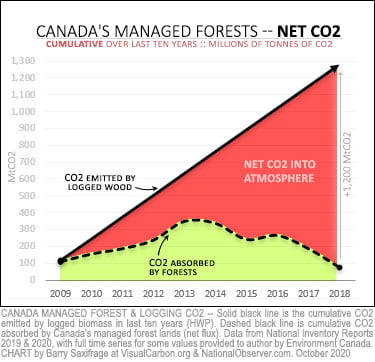
The rising black line shows the cumulative CO2 emitted by the logging industry's harvested wood over the last 10 years. These logging emissions added up to more than 1,200 million tonnes of CO2 (MtCO2).
Now compare those emissions to what our managed forests were absorbing over those same years. That's the faltering lower dashed line. The forests absorbed less than 100 MtCO2 — not even one-tenth of what the logging industry emitted.
The remaining 90 per cent of those logging emissions, shown by the red area, have been accumulating in our atmosphere, intensifying climate disruption. The decision to keep cutting more than is growing back has resulted in more than a billion tonnes of excess CO2 emissions — so far. And, as we will see in detail below, the long-term trend lines show the problem growing increasingly worse.
That's the grim story told by the data in Canada's official National Inventory Reports (NIRs). I've dug into that data to create a series of charts that illustrate what's going on.
What they show is that this flood of climate pollution has now grown too large and out of control to keep ignoring. Ottawa needs to start acting on this threat while we still have a shot to rein it in.
The logging industry continues to cut faster than Canada's managed forests can keep up with. The resulting flood of CO2 is a rapidly growing climate threat, @bsaxifrage writes, and Ottawa needs new climate policies to rein it in. #climatechange
The climate science is clear that avoiding a full-blown climate crisis requires us to reduce all our emissions to zero in the next few decades.
Canada's current efforts to do this includes a price on climate pollution — a carbon tax levied on most sources of emissions in the other sectors. It's small fee, but it's a start.
As the federal Canadian government says: “A price on carbon pollution is an essential part of Canada’s plan to fight climate change and grow the economy. Pricing carbon pollution is the most efficient way to reduce greenhouse gas emissions and stimulate investments in clean innovation. A price on carbon pollution creates incentives for individuals, households, and businesses to choose cleaner options.”
However, Ottawa continues to exempt one of our largest sources of climate pollution — the roughly 155 MtCO2 per year emitted by the logging industry's harvests. (For a detailed breakdown of these emissions, see the article endnotes.)
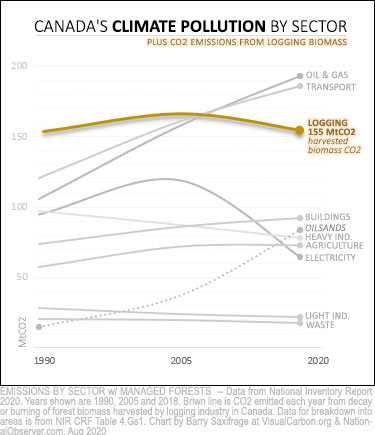 To put the scale of these logging emissions into context, my next chart compares them to all other sectors in Canada. I've also included a grey dashed line showing the oilsands industry portion of the oil and gas sector.
To put the scale of these logging emissions into context, my next chart compares them to all other sectors in Canada. I've also included a grey dashed line showing the oilsands industry portion of the oil and gas sector.
Roughly three-quarters of emissions in the rest of our economy are covered by our national carbon pollution pricing. However, all 155 MtCO2 in logging emissions are excluded from the carbon tax.
In addition, Ottawa also exempts logging emissions from our other emission-reduction policies and targets. For example, under Canada's 2030 Paris Agreement pledge, the target for all other sectors is a 30 per cent emissions cut. But Ottawa created a separate target just for these logging emissions that allows them to rise, not fall.
These special exemptions for logging emissions are based on the notion that our managed forests are reabsorbing as much CO2 as logging creates. This, they argue, makes the logged wood “carbon neutral.”
Sadly, this isn't happening anymore. As we've seen above, and will see in even more detail below, the government's own data shows that the logging industry has been cutting and emitting more than our managed forests are able to absorb.
As U.S. President Donald Trump learned with COVID-19, ignoring a clear and growing threat won't make it “disappear … like a miracle.”
Likewise, efforts in Canada to push this clear and growing threat off our books with creative accounting simply allows the crisis to spiral out of control. What we need instead are new policies from Ottawa to address this threat.
The climate-safest new policy option would be to require logging emissions to not exceed what our managed forests absorb. That would stop the CO2 flood and return the forests to net zero. Doing this would require a lot of government support for the impacted forestry workers and forestry economy. But it could also have significant long-term economic benefits compared to the current path of not acting.
For example, it would make it easier to convince clean tech investors and the global marketplace that Canadian forest products are — and will remain — carbon neutral. If you think selling thermal coal is getting hard to do, imagine trying to sell wood that isn't considered carbon neutral for burning. Burning wood is even more climate-polluting than coal per unit of energy. The long-term sustainability for our logging industry, and the social licence that goes with that, depends upon not cutting more than grows back. And rebuilding the forest carbon sink to be larger than what logging emits could also restore some of the valuable forest carbon offsets that other industries count on.
Alternatively, if Ottawa decides it wants to allow the logging industry to keep emitting more CO2 than our managed forests are absorbing, then it should at least apply our national carbon pricing to the industry's emissions. For the same good reasons it applies it to our other excess emissions sources.
I can see reasonable arguments for either limiting logging emissions to match the forest sink or for imposing a climate pollution fee on the excess logging CO2.
But there is no reasonable case for continuing to ignore the surging climate threat posed by our managed forestry emissions.
To better understand the dramatic CO2 changes unfolding in Canada's managed forests and the growing threat they pose, let's dig a bit deeper into the data.
I'll start with the most critical number — the net CO2 balance of Canada's managed forests. This includes both the CO2 absorbed via tree growth and the CO2 emitted by trees that decay or are logged.

This net CO2 exchange with the atmosphere is what our climate system reacts to. On my chart, it's shown by the bold black line.
As you can see, back in the 1990s, the CO2 balance was mostly down in the green area. That means our forests were overall CO2 absorbers (carbon sinks). They grew back faster than they were logged and helped slow climate change.
But since then, the CO2 balance has moved increasingly upwards into the red zone. In these more recent years, our managed forests became CO2 emitters (carbon sources). That means the growth rate couldn't keep pace with logging. This has intensified climate change.
In 2018, for example, net emissions into the atmosphere totalled 240 MtCO2. That was more climate pollution than even our oil and gas or transportation sectors emitted that year. This is not a climate threat we can safely ignore.
My next chart breaks down the net CO2 balance into its two components. In its NIR, Canada reports forestry CO2 in two parts: forest growth and logging emissions.

The first part, forest growth, is now shown on the chart as the lower dotted line. It's the balance of growth and decay.
The second part, logging emissions — at roughly 155 MtCO2 per year — is shown by the shaded area on top of it.
Specifically, this logging CO2 is what is emitted by logged trees and other forest biomass when it gets burned for energy or when it rots at the end of its use. It also includes emissions from slash left behind by logging.
As this more detailed chart makes clear, net forest growth has been weakening for decades.
This weakening is not part of a normal cycle. It is being driven by a combination of human actions. These include forestry practices that have weakened forest health and resilience, like clear cutting old-growth and replacing it with single-age, single-species monocultures. And they include human-fuelled climate changes that are turbocharging the four horsemen of forest decay: wildfires, insect kills, droughts, and storms. (For details see my forest carbon explainer.)
What this chart also shows is that logging emissions have stayed high even as forest regrowth has plunged. As a result, logging emissions have increasingly exceeded what Canada's managed forests absorbed. The excess CO2 — indicated by the shaded area up in the red zone — has been accumulating in our atmosphere, worsening the climate and ocean acidification crises.
The chart above shows a forestry system in trouble and hemorrhaging CO2. But the big annual swings in that chart can make it hard to see how robust the underlying trends are. Is this just a few freak years or is it a consistent shift? Is the trend improving or growing worse?
When climate scientists and policymakers are confronted with “noisy” data like this, they look at multi-year averages to understand long-term trends.
My next chart does just that. I've faded out the annual lines and overlaid them with their 10-year running averages. Each point on these trend lines is the average of the 10 years leading up to it.
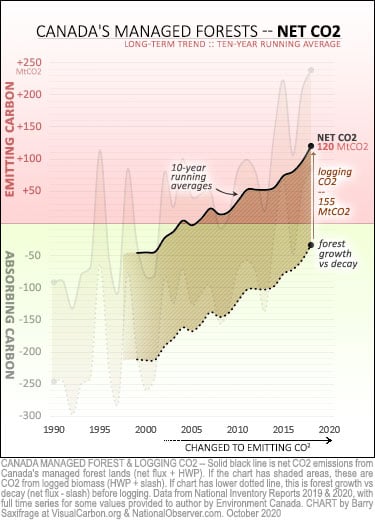
As you can see, the transition from valuable carbon sink into super-emitting threat has been a robust, steady, multi-decade trend that shows no signs of stopping under continued business-as-usual.
To reverse this threat, Ottawa will need new policies that start restoring the forest carbon sink, while also addressing the huge amounts of logging emissions that exceed it.
The one glimmer of hope that I see for returning our forests to much-needed carbon sinks is shown by the dotted bottom line. It shows that the long-term trend in forest growth — before logging — is still a small net sink. That means we might still be able to manage our forestry so it is both climate safe and sustainable.
As it is, however, the decade average for business-as-usual logging emissions has now risen 120 MtCO2 more each year than our managed forests are able to offset.
I'll wrap up by adding this long-term trend line to the sector emissions chart.
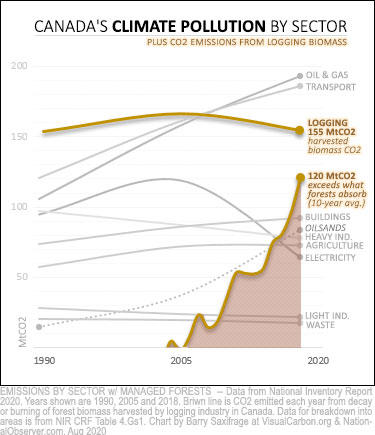
As before, the top brown line shows the total emissions from all the wood logged each year. That's currently running around 155 MtCO2 a year.
And the long-term trend for the amount that exceeded what the forests absorbed is shown by the lower brown line that's rocketing upwards. That's averaged at 120 MtCO2 per year over the last decade.
Either way you slice it, logging industry emissions dwarf nearly every other source of climate pollution in our country. In fact, they exceed what 150 countries emit for everything.
Does that look like “carbon neutral” logging to you?
Does it look like we are heading toward a safe climate future by continuing to ignore emissions at that scale?
Not to me. What it looks like to me is a runaway carbon train with the conductors still shovelling fuel into the firebox. The people in charge of our climate and forestry policies need to start acting on this threat before it derails both our hopes for both a safe climate future and for a long-term sustainable forestry economy.
EXTENDED ENDNOTES
Canada's forestry carbon accounting can be confusing for many. The media rarely has time to dig into the data deep enough to fully explain what's going on. And the government keeps shifting how and where it reports forest carbon data in the NIR. The government even keeps changing the targets for it. So, for those readers who would like a bit more detail on what was covered in this article, I've added some more in-depth endnotes.
Breaking down logging CO2 into its many sources
The vast majority of logging emissions come from the wood and other forest biomass it cuts. That's the roughly 155 MtCO2 per year that was discussed in this article. These are the emissions that Canada currently exempts from our carbon pricing and other climate reduction policies and targets.
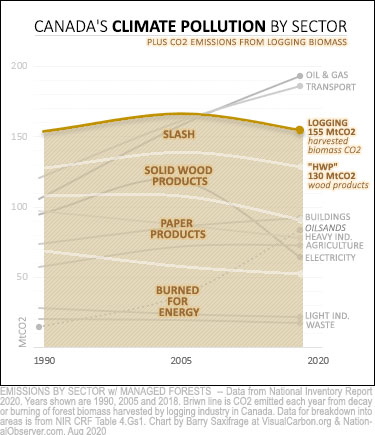
These emissions come from four major sources, as shown on my chart.
The biggest source is burning forest biomass for energy. It emits more than 50 MtCO2 per year. For comparison, that's roughly the same as all the coal burning in Canada. Canada rightly carbon taxes coal CO2 to fight the climate crisis. But it gives an equivalent amount of CO2 from burning wood a free pass. To make matters worse, burning wood actually releases more climate pollution per unit of energy produced than coal does.
The second-biggest source comes from discarded paper and paperboard products. These emit around 40 MtCO2 a year.
Nearly as much gets emitted by solid wood products that have likewise been discarded at the end of their useful life.
Together, these three sources make up the “Harvested Wood Products” (HWP) category. This is all the biomass physically removed from the forests by logging. Canada tracks and reports HWP emissions as a top-level item in the NIR each year. It has been reported at around 130 MtCO2 per year in recent years.
The final big source is known as “slash.” This is the emissions from all the biomass debris left behind by logging and from all the carbon-rich forest soils disturbed by logging operations. These together emit a guesstimated 20 to 25 MtCO2 per year.
Finally, the logging industry also emits another 8 MtCO2, more or less, from burning fossil fuels. These emissions are appropriately subject to Canada's carbon tax. They are accounted for under the relevant sectors, like Transportation.
Where to find the data for managed forest CO2 in the NIR
All the data used in this article was published in Canada's NIR. But recent changes in how Canada accounts for forestry emissions have made some of it hard to find. Here's where to find the data I used:
Looking for even more info?
If you want a broader overview and even more details on forest carbon in Canada, you can try my in-depth forest carbon explainer.
[Top photo: The logging industry continues to cut faster than Canada's managed forests can keep up with. Photo by: Joe Stone]